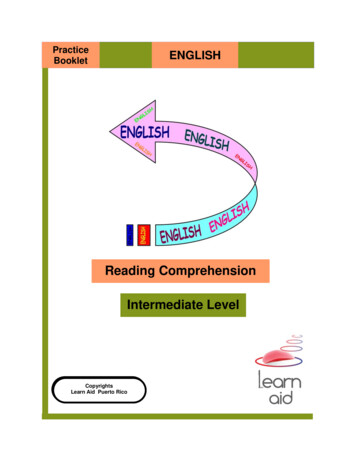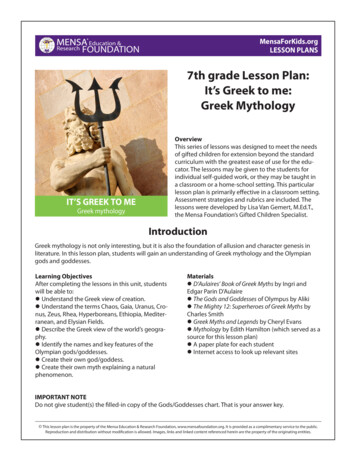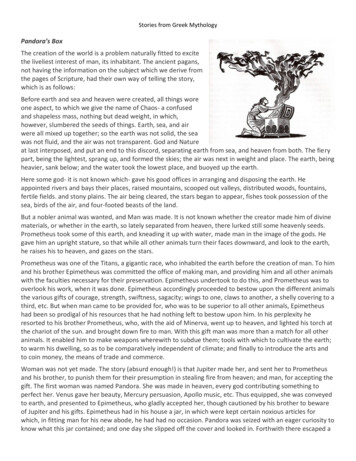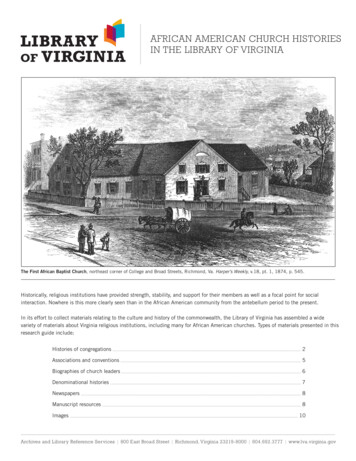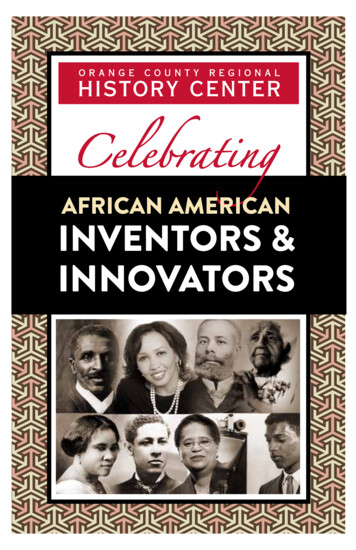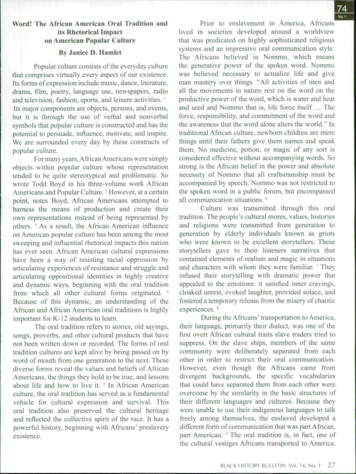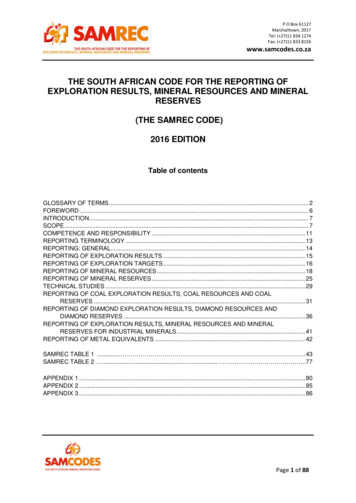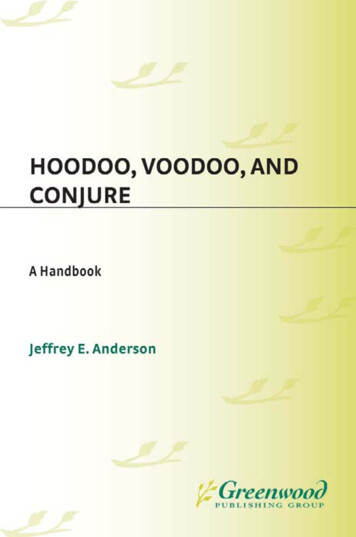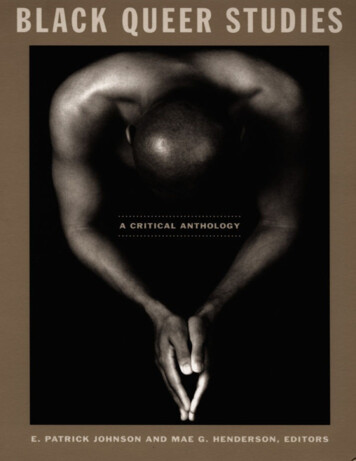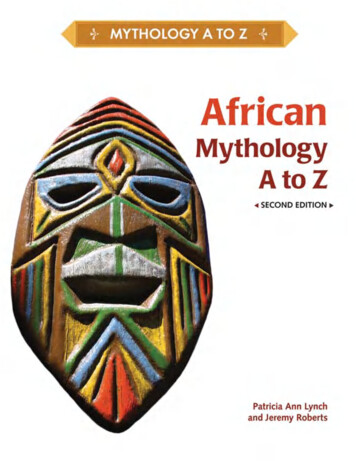
Transcription
AfricanMythologyA to Zsecond Edition
MYTHOLOGY A TO ZAfrican Mythology A to ZCeltic Mythology A to ZChinese Mythology A to ZEgyptian Mythology A to ZGreek and Roman Mythology A to ZJapanese Mythology A to ZNative American Mythology A to ZNorse Mythology A to ZSouth and Meso-American Mythology A to Z
MYTHOLOGY A TO ZAfricanMythologyA to Zsecond Edition8Patricia Ann LynchRevised by Jeremy Roberts
[African Mythology A to Z, Second EditionCopyright 2004, 2010 by Patricia Ann LynchAll rights reserved. No part of this book may be reproduced or utilized in any form or by any means,electronic or mechanical, including photocopying, recording, or by any information storage orretrieval systems, without permission in writing from the publisher. For information contact:Chelsea House132 West 31st StreetNew York NY 10001Library of Congress Cataloging-in-Publication DataLynch, Patricia Ann.African mythology A to Z / Patricia Ann Lynch ; revised by Jeremy Roberts. — 2nd ed.p. cm.Includes bibliographical references and index.ISBN 978-1-60413-415-5 (hc : alk. paper) 1. Mythology—African. 2. Encyclopedias—juvenile.I. Roberts, Jeremy, 1956- II. Title.BL2400 .L96 2010299.6' 11303—dc22 2009033612Chelsea House books are available at special discounts when purchased in bulk quantities forbusinesses, associations, institutions, or sales promotions. Please call our Special Sales Departmentin New York at (212) 967-8800 or (800) 322-8755.You can find Chelsea House on the World Wide Web at http://www.chelseahouse.comText design by Lina FarinellaMap design by Patricia MeschinoComposition by Mary Susan Ryan-FlynnCover printed by Bang Printing, Brainerd, MNBood printed and bound by Bang Printing, Brainerd, MNDate printed: March 2010Printed in the United States of America109 876 54 32 1This book is printed on acid-free paper.All links and Web addressess were checked and verified to be correct at the time of publication.Because of the dynamic nature of the Web, some addresses and linksmay have changed since publication and may no longer be valid.
Contents8IntroductionviiMap of Modern AfricaxviiiCountries and Tribal RegionsTime Line of African HistoryA-to-Z EntriesSelected BibliographyIndex143xixxxiii1139
Introduction8The first impression one gets of Africa is its size. Africa is the world’s second largestcontinent in area (after Asia). The continent spans about 5,000 miles from northto south and about 4,600 miles from east to west at its widest part in the north.The geography of Africa is as varied as one might expect in such an immense area.Strips of fertile land at northern and southern extremes of the continent graduallyfade into the vast reaches of the Sahara Desert in the north and the smaller Kalahari Desert in the south. Narrow bands of brush and scrub forest and grasslandsborder the deserts. Tall mountains—many of which are extinct volcanoes—towerover the rolling, grassy savannas. Broad and powerful rivers cut across the continent, making their way to the sea. In the center of Africa is a great equatorial rainforest. Wherever the land was capable of supporting human life, people settled.They developed agriculture and animal husbandry, learned metalworking, foundedcities, and built empires.To refer to “Africans” or “African culture” as if the inhabitants of this enormous continent represent one people is an error. People’s ways of life, religions,traditions, and mythologies vary greatly from region to region and even from onetribe to a neighboring tribe. Wherever they lived, Africans developed lifestyles,worldviews, religions, traditions, and mythologies that were as different from oneanother as their physical environments.Also because of its size, outside influences on Africa varied from place to place.The great civilization of ancient Egypt dominated other cultures that developedalong the Nile River. Peoples on the Red Sea coast were influenced by the peoplesof southern Arabia across the sea. North Africa, which borders the MediterraneanSea, is just eight miles across the Strait of Gibraltar from Europe. It was settled bythe ancient Phoenicians, Greeks, Romans, and Arabs, all of whom exerted their owninfluences on North African culture, traditions, and mythologies. Central Africa,south of the Sahara, remained uninfluenced by outside civilizations for millennia. Itspeoples developed their own unique religions, worldviews, and mythologies.Humans use mythology and ritual to establish a sense of community, identity,and an understanding of their place in the universe. These tools maintain thetraditions of a culture and reflect what is most important in people’s lives. We readmyths not only to learn about the culture in which the myth originated but to discover what was in the hearts and minds of the mythmakers. This book explores thesurviving mythological traditions of Africa outside Egypt, from the earliest knownmyths to the most recent. (Egyptian mythology is covered in our volume EgyptianMythology A to Z.) The myths of African peoples give us a glimpse into their ways oflife and worldviews. Because of the vast numbers of traditions and almost limitlessnumbers of tales, it is impossible to represent them all in a book of this size. Wevii
viii African Mythology A to ZAncient Africans were painting pictures on rock croppings and cliffs some 30,000 years ago. These ancientpictographs from Libya feature animals, people, and mythological symbols. (Photo by Clara/Shutterstock)have attempted to include a sampling of myths that are representative of particularcultures and that come from as wide a variety of cultures as possible.Africa: A Brief HistoryAfrica has a long and dynamic history that goes back millions of years. Humanlife began in Africa. Anthropological evidence in the form of fossil skulls, bonefragments, and other artifacts shows that the first hominids—upright primates whowalked on two legs—evolved in East Africa around 5 million years ago. By 700,000years ago, hominids who migrated out of Africa had spread throughout Asia andEurope. Fossil remains of the first modern humans—Homo sapiens—that dateback 160,000 years were found in Ethiopia in 2003. This is evidence that modernhumans also evolved in Africa and spread out from there.Prehistoric African PeopleSome 30,000 years ago, the san people of southern Africa began painting pictureson rock outcroppings and cliffs. San rock art is a valuable aid to understanding Sanreligion and mythology, both of which have survived to this day.Over many thousands of years, the geography of Africa has changed morethan once. Between around 5500 and 2500 b.c., the continent’s climate becamewetter. The northern half of Africa became a lush prairie, populated by hunters,herders, and farmers. Archaeologists have learned about these people’s lives fromthe thousands of rock paintings discovered throughout the region. Scenes showingeveryday activities, rituals, musicians, and decoratively costumed dancers give a
Introduction ixglimpse into the customs, traditions, and ceremonial lives of these ancient people.Nothing, however, is known about their myths.About 4,000 years ago (around 2000 b.c.) the climate changed again; it becameincreasingly drier. Lands that were once fertile became desert. Today, the sands ofthe Sahara cover the beds of ancient rivers and the ruins of cities that flourishedlong ago. The people of the Sahara migrated to more hospitable lands. Theytook with them their religions, customs, traditions, and mythology. From theSahara, people dispersed in three directions. Some went north to the coast of theMediterranean Sea. There, they merged with the local people and formed theBerber culture. Some settled in the fertile lands along the Nile River and laterbecame known as Libyans. Still others migrated south into the heart ofthe continent.The Rise of African KingdomsSome of history’s oldest and mostadvanced civilizations developed inAfrica. The civilization of Egyptarose around 5500 b.c. and flourished between 1550 and 1069 b.c.It was conquered by Alexander theGreat in 332–323 b.c. The firstAfrican civilization after Egypt wasKush. The Kushites were an Egyptianized people who lived betweenthe first and third cataracts of theNile River. Around 3100 b.c., Egypthad conquered and colonized theregion around the first cataract—known as Nubia—spreading Egyptian civilization southward. Kushgrew so strong that in the eighthcentury b.c. it conquered Egypt andruled it for 90 years. The Kushitereligion closely resembled Egyptianreligion. It contained all the majorEgyptian gods, with Amon as theprincipal god, and the related Egyptian mythologies as well.The Kushite dynasty ended withthe Assyrian invasion of Egypt in theseventh century b.c. The Kushitesretreated south. In 591, the capitalmoved to Meroe. By about 270, Meroehad become an empire that lasted for500 years. In addition to Egyptiandeities and mythology, Meroe hadits own regional gods; among themwas a lion-headed warrior god whoappears in rock carvings.While Meroe declined, the kingdom of Axum in the highlands ofwhat is now Ethiopia grew in power.This figurine, found in the burial placeof King Senkamanisken of the Kushites,dates to 623 b.c. and closely resemblesworks of the Egyptian culture that camebefore it. (Unattributed photo/Used undera Creative Commons license)
African Mythology A to ZAccording to Greek and Roman sources, Axum was thriving by the first century a.d.Axum’s language and system of writing were Semitic. After conquering Kush andacquiring territories in Arabia, Axum controlled one of the most important traderoutes in the world. The Axumite religion was derived from Arabic religion andwas polytheistic, or based on the belief in many gods. In Axumite mythology, godscontrolled the natural forces of the universe. In the fourth century a.d., Axum’sruler was converted to Christianity. He declared Axum a Christian state—the firstin the world. Axum remained a strong empire and trading power until the rise ofIslam in the seventh century a.d.Africans developed iron-making technology early, around the sixth centuryb.c. Beginning in the first century a.d., knowledge of iron making began tospread quickly throughout the continent. The spread of this important technology was the result of the migrations of Bantu-speaking people. Bantu is a familyof closely related languages that represent the largest language family in Africa.Around the first century b.c., Bantu-speaking people migrated out of northcentral Africa and spread south and east. This migration continued until abouta.d. 1000. Wherever the Bantu migrated, they brought with them their language,culture, agricultural skills, knowledge of technology, traditions, and mythology.Themes common to Bantu mythology predominate in areas into which theBantu migrated.Islam and TradeThe most important development in the Sahel region, south of the Sahara, was theuse of the camel as a means of transport. Under the influence of Islamic peoples,northern and western Africans began to use camels to transport goods across theSahara around a.d. 750. All of the major North African kingdoms—Ghana, Mali,Songhay, and Kanem-Bornu—arose at way stations and at the southern terminalpoints of trade.Ghana’s power and influence were built on trade—especially trade in gold.Ghana was originally founded by Berbers but became dominated by the Soninke,a Mandé-speaking people. Fragments of the ancient Soninke traditions andmythologies survive in the Dausi, the great epic of the Soninke people. Ghana wasconquered by the Almoravid Berbers in a jihad, or Islamic holy war, around 1076and ceased to be a commercial power.According to tradition, the Sahelian kingdom of Mali was founded by thelegendary hero Sundiata (also called Son-Jara Keita, Sundjata Keoto, or SunjataKayta). Many myths are told about Sundiata’s exploits. After the death of Mali’smost significant king, Mansa Musa (ruled 1312–1337), Mali’s power declined.Much of its territory was seized by Tuareg Berbers in the north and the Mossikingdom to the south.Mali was replaced by the Songhay kingdom, which arose from Gao, a formersubject kingdom of Mali. Songhay eventually became a powerful empire.Although Songhay was a Muslim empire, the large majority of its peoplefollowed traditional African religions and retained traditional African mythologies. In the late 1500s, Songhay grew too large for imperial rulers to controlits territory. Many of its subject peoples revolted, and it was defeated by theMaghreb people of Morocco in 1591. The greatest empire in African historyended in 1612.Near Central Africa, another great empire called Kanem arose around 1200.This empire was formed by a group of tribes called the Kanuri. The historic
Introduction xileader of the Kanuri, Mai Dunama Dibbalemi (1221–1259), was the first Kanurito convert to Islam. At the height of their empire, the Kanuri controlled territoryfrom Libya, to Lake Chad, to the lands of the Hausa people. By the early 1400s,Kanuri power shifted from Kanem to Bornu, a Kanuri kingdom southwest ofLake Chad. When Songhay fell, the new empire of Bornu grew rapidly. In 1846,however, Kanem-Bornu fell to the growing power of the Hausa states. AlthoughKanem-Bornu fell, myths of the Kanuri have survived.Other great states arose in the forests of western Africa south of the Sahel. Thegreatest of these was Benin in what is now southern Nigeria. Benin was foundedby Edo-speaking people around 1170. Benin is best known for its art, in particulardetailed brass plaques and statuary that recount important events in Benin history, such as the arrival of the Portuguese. Benin was still a powerful state whenEuropean powers began seizing colonial territory in Africa in the 19th century.Benin held out against the European invaders until the British dismantled theBenin state in 1897. The people of Benin and its neighbor, the Oyo empire (whosepeople spoke Yoruba) had elaborate pantheons of deities comprising hundreds ofgods and goddesses. The mythologies related to these religions are detailed andextensive.One of the few city-states south of the Sahara that never felt the effects ofIslam was Great Zimbabwe, which arose around 1085. Great Zimbabwe itself wasa palace and fortress surrounded by huge stone walls made without any mortar.By the 13th century, Zimbabwe dominated the Zambezi Valley both militarily andcommercially as the Mwenemutapa empire. Most of the site was abandoned inthe late 15th century, for unknown reasons. The people of Great Zimbabwe werethe ancestors of today’s Shona people and may have held the same religious andmythological beliefs.European InfluenceHistorically, West Africa is associated with the slave trade, which existed beforethe coming of Europeans. From the mid-15th century on, Europeans played anincreasingly prominent role in the trade, which grew significantly as a result.Some historians estimate that between 1450 and 1850, some 28 million Africanswere forcibly removed from central and western Africa. These men and womenwere sent to European colonies and plantations in the Americas and the Caribbean as slaves. Displaced Africans brought their rich cultural traditions, religions,oral arts, and mythologies with them. Vodun, the religion of the Fon of Benin,is still practiced in Cuba, Haiti, and parts of the United States. African folktalesabout trickster animals such as the tortoise, hare, and spider assumed newlives in American folk tales. Stories about Br’er Rabbit that originated in theAmerican South and became popular throughout the United States in the 1800sderived from the Bantu trickster hare, Kadimba.The first European colony in Africa was the Portuguese colony of Angola,established in 1570. Other European colonies followed: The Dutch and Britishcolonized South Africa, and Belgium, France, Germany, and the Netherlandsestablished colonies throughout Africa. To end the sometimes violent conflictbetween nations fighting for control of African territory, European leadersmet in Berlin in 1884 to establish “spheres of influence”—in other words,to divide the continent among themselves. The boundaries of present-dayAfrican countries were largely determined at the Berlin Conference. By theearly 1960s, African nations achieved independence and established their owngovernments.
xii African Mythology A to ZThis slavery memorial in Zanzibar, Tanzania, commemorates the terrible tollEuropean slave traders took on African communities. Millions of Africanswere captured and sold as slaves to work on American- and European-ownedplantations. (Photo by Red Frisbee/Shutterstock)Themes of African MythologyAfrica did not develop one overall myth system, because Africa itself does nothave one people, one history, or one language. African peoples speak more than2,000 different languages. They have almost as many traditions of behavior andbelief and mythologies. Still, common themes do exist. Linguists divide indigenous African languages into four distinct language families: Afro-Asiatic, NiloSaharan, Niger-Congo, and Khoisan. A fifth group includes Indo-Europeanlanguages (Afrikaans, English, and Creole Portuguese) and Malayo-Polynesian
Introduction xiii(Malagasy, spoken on the island of Madagascar). A comparison of the mythologies of different groups within the same language family provides the followinggeneralizations.Afro-Asiatic (North Africa, East Africa) This language family reflects theinfluence of ancient Egyptian mythology, with its theme of the soul’s journey afterdeath. A related theme is the division of the world into three realms: the underworld, where the souls of the departed reside, the middle world of the living, andthe upper world that is the home of the deities.Nilo-Saharan (Central Africa) The predominant mythological theme inthis language family is a recurring creation account in which heaven and Earthwere originally close together and connected by a link (chain, leather strip, rope,spider web) that permitted humans and the divine beings to reach one another.Then something occurred that caused a separation—in various myths it wasdisobedience, violence, or a misunderstanding—and the link between heavenand Earth was broken. The supreme being receded from humanity, and deathcame into the world.
xiv African Mythology A to ZModern-day storytellers may use microphones to reach their audiences, but theirmyths and folk tales remain faithful to tribal history and religion. (Photo by Daniel Korzeniewski/Shutterstock)Niger-Congo (West Africa, East Africa, southern Africa) The largest ofthe families of languages spoken in Africa, this language family can be furtherdivided into Bantu and non-Bantu mythologies. Bantu mythology includes a richcollection of epics—long, narrative stories recounting the deeds of a legendary orhistorical hero. Epic heroes traditionally undertake journeys during which theysuffer terrible ordeals and confront monsters, magical forces, and evil beings. Thehero’s travels may take him to distant lands, to the sky world, and to the land of thedead. The hero returns home victorious and receives rewards—sometimes a king-
Introduction xvship—for his accomplishments. Non-Bantu mythology represents sophisticatedsystems of cosmology. In Dogon mythology, for example, creation emerged froma series of divine words, and the human body is presented as a divine oracle. InBambara mythology, the universe was created from the root sound Yo. Non-Bantumythologies are also characterized by elaborate pantheons of gods and goddesses,each with a specific realm and function.Khoisan (southern Africa) The term Khoisan combines the names of theKhoikhoi (formerly Hottentot) and San (formerly Bushmen) peoples. The mythology of the San is centered on the San master animal, the eland, and the prayingmantis, both of which are identified with the San Supreme Being, who wasbelieved to transform himself into these creatures. San mythology is represented inrock paintings and engravings that are up to 30,000 years old, with correspondingmyths that are probably just as old.Sources of African MythologyEgypt and the Nile kingdoms of Nubia and Kush had long traditions of writing. It is from written records that we know about their deities, traditions, andmythologies. Similarly, the Meroic empire had a writing system acquired throughits ties to the Semitic peoples of southern Arabia. The most important factor inthe spread of literacy throughout Africa was the Islamic invasions, which beganwith the conquest of Egypt in a.d. 646. By the 1300s the kingdoms of the Sahelhad been converted to Islam and became centers of Islamic learning. At first, manyThese Samburu women are performing a “call and response” type of song commonly used in traditionalstorytelling. (Photo by Cecilia Lim H. M./Shutterstock)
xvi African Mythology A to ZAfricans dealt with two languages—their native languages and Arabic. Eventually,though, they began to write in their own languages using the Arabic alphabet.With literacy, Africans could record their own histories, legends, and myths. Anearly known example of East African literature, dated 1520 and written in Arabic, isa history of the city-state of Kilway Kisiwani. Histories of other city-states writtenin Swahili appeared soon after. The earliest known work of literature—a Swahiliepic poem titled Utendi wa Tambuka (Story of Tambuka)—was written in 1728.Africa has a long and rich oral tradition that survives to this day. Culturalbeliefs, traditions, histories, myths, legends, and rules for living have been passeddown orally from generation to generation. The keepers of the oral tradition arebards—tribal poet-singers and storytellers. Bards are charged with rememberingand passing along a culture’s history and tradition through story and song. Almostall existing epics come from recordings of live performances by African bards(known by the French term griot in western Africa).African storytelling has always been an interactive process, in which audiencesare encouraged to help tell the story. Songs are an important part of the story.Often, a bard will team up with a singer to perform myths and legends. The bardwill act as the narrator, introducing the characters and telling their stories. Attimes, the singer will take over and lead the audience in what is known as a “calland response” style of storytelling. Taking the part of one of the characters, thesinger will sing a line or two and then encourage the audience to respond with aspecific refrain. For example, in a tale about an orphan who visits her mother’sgrave, the call and response goes something like this:Singer: “Oh Mother, I am hungry, I am hungry.”The audience (responding as the dead mother): “My daughter suffers. Mydaughter suffers.”Singer: “My older sister gives me rotten cornmeal to eat.”The audience: “My daughter suffers. My daughter suffers.”Because they are part of an oral tradition, African myths and legends are flexibleand creative, depending on who is telling the story and why. Tribal elders may usea particular legend to teach religious beliefs or reinforce proper behavior, whilechildren often tell the same stories for their own amusement. For example, astoryteller who wants to warn children about the dangers of wandering off may tella folk tale in which a disobedient child is shredded to bits by a sharp-toothed lion.Choosing the same tale to teach mothers to keep track of their children, the storyteller might create a character of a foolish mother whose laziness is responsiblefor her child being eaten by the lion. A child who tells the same story to a group offriends might want to emphasize how clever children are, making the disobedientchild outsmart the lion by doing something silly, like farting in its face to get away.An adult telling the same story might show the father saving the child from thelion by diverting the lion’s attention with a whistle.European explorers, anthropologists, and missionaries were also sources ofinformation about African religions, customs, traditions, and mythologies. One ofthe most important of these persons—in terms of the quantity of records of Africanculture he gathered and published—was the German explorer and ethnologist LeoFrobenius (1873–1938). Between 1904 and 1935, Frobenius led 12 expeditions toAfrica. His collections of African epics, legends, myths, and folk tales—which includethe famous Soninke and Fulbe epics—were enormous and were published in 12volumes.Finally, present-day religions are an important source of African mythology. Themythologies of African cultures cannot be separated from African religions. Many
Introduction xviiAfrican religions are living religions not only in Africa but also in parts of the worldwhere people of African descent live. It is through these contemporary religions thatwe have learned much about traditions, practices, and beliefs of the past.Pronunciation of African Names and TermsBecause so many different African languages are represented in this guide, noattempt has been made to include pronunciations of African names and terms.However, these general guidelines can be followed: Words are pronouncedphonetically with all consonant and vowel sounds made; no vowels are silent, assome are in English. A final e is usually pronounced with a long a sound as in ray.A final i is usually pronounced with a long e sound as in me. A double vowel—aa,for example—represents a drawn-out vowel sound: ahhh.Languages of the Khoisan language family are spoken with unique vocalized“clicks” made by sharply pulling the tongue away from different parts of themouth. The following symbols indicate which part of the mouth is used:Symbol Technical Term Location।DentalBack of the teeth।।LabialSide of the teeth near the cheek!AlveolaFront part of the roof of the mouth Alveo-palatalFarther back on the palate, roof of the mouthHow to Use this BookThe entries in this book are in alphabetical order and may be looked up as youwould look up words in a dictionary. The index at the back of the book will helpyou to find characters, topics, and myths. For some individual entries, alternativenames and spellings are provided in parentheses following the main entry, as areEnglish translations of the African names. The cultural region associated with theterm is also often given, in italics, followed by the modern nation that now existsin that region in italics and within parenthesis. Cross-references to other entriesare printed in small capital letters.
xviii African Mythology A to ZModern africa
Countries andTribal Regions8North AfricaAlgeriaArab, Berber, Kabyle, TuaregChadBedouin, Fulani, Maodang, Massa, Sara, TuaregLibyaArab, Berber, TuaregMoroccoArab, Berber, LamtunaNigerDjerma, Ekoi, Fulani, Hausa, Isoko, Songhai, TuaregSudanAma, Anuak, Azande, Bari, Beir, Bongo, Bor, Burun, Didinga, Dilling, Dinka,Fajulu, Gaalin, Jo Luo, Jumjum, Kakwa, Kuku, Lokoiya, Lotuko, Lugbara,Mahraka, Meban, Mondari, Moru, Ndogo, Nuba, Nuer, Sara, Shilluk,Topotha, ZandeTunisiaArab, Berber, MaktarWest AfricaBeninBargu, Bariba, Bini, Edo, Ewe, Fon, Igbo (Ibo), Kyama, TwiBurkina FasoAkan, Awuna, Bwa, Bobo-Fing, Djerema, Dogon, Gurunsi, Kasena, Korumba,Lobi, Lodagaa, Mossi, Nunuma, Talensi (Tallenzi), TusyanCôte d’Ivoire (Ivory Coast)Adjuru, Agni, Akan, Anyi, Baoule, Dan, Ebrie, Guro, Kru, Kyama, Lobi,Mande, Senufo, Yakouba, YaoureGambiaMandinka, SererGhanaAkan, Anlo, Ashanti (Asante), Birifor, Dagomba, Ewe, Fante (Fanti), Ga,Grunshi, Kasena, Konkomba, Kulango, Mamprusi, Moshi, Talensi(Tallenzi), Twixix
xx African Mythology A to ZGuineaBaga, Kissi, Kono, Landumo, Lodagaa, Mdinge, Nalou, Susu, Tenda, TomoGuinea BissauBijogoLiberiaBassa, Bete, Geh, Gio, Grebo, Guere, Kissi, Kono, Kpelle, Kra, Kru, Mano,Poro, Sande, Vai, WobeMaliBambara, Belle, Bozo, Dogon, Fulani, Fulbe, Habbe, Malinke, Mandé, Mandinka, Marka, Mdinge, Minyanka, TuaregMauritaniaSoninkeNigeriaAbua, Afusare, Anang, Bachama, Basa, Binawa, Bini, Bura, Chamba, Chawai, Dorei, Dungi, Edo, Efik, Egede, Ekoi, Fulani, Gbari, Hausa, Ibibio,Idoma, Igbin, Igbira, Igbo (Ibo), Ijaw, Ijo, Indem, Isoko, Itsekiri, Iyala, Jen,Jompre, Jukun, Kadara, Kaibi, Kalabari, Kangoro, Katab, Kitmi, Kurama,Mama, Margi, Mumuye, Nkum, Nupe, Orri, Pabir, Piti, Pyem, Rishuwa,Rukuba, Rumaiya, Srubu, Tangale, Tiv, Urhobo, Yachi, Yako, YorubaSenegalBassari, Diola, Fulani, Mandinka, Peul (Fula), Sarakholé, Serer, Tukulor(Tukuleur), WolofSierra LeoneKono, Limba, Mendi (Mendi), TembeTogoBassari, Ewe, Fon, Konkomba, Krachi, MobaWestern SaharaArab, BerberCentral AfricaBurundiHutu (Bahutu), Rundi (Barundi), Tutsi (Watutsi), Twa (Batwa)CameroonBachama, Bafut, Baka, Bali, Bamenda, Bamileke, Bamoun, Bamum, Banen,Baranga, Bekom, Bulu, Duala, Ekoi, Fali, Fang, Gyelli, Keaka, Kpe,Malimba, Mambila, Mankon, Pangwe, Pongo, TikarCentral African RepublicAka, Baya, Benzele, Boloki, Fang, Pahouin, ZandeDemocratic Republic of the CongoAke, Alur, Bachwa, Bakuba, Bembe, Bindji, Bushongo, Buye, Bwaka, Efe,Goma, Hamba, Holoholo, Kongo, Kuba, Lega, Luangu, Luba, Lugbara,Lunda, Lwalwa, Mbole, Mbuti, Mongo, Ngombe, Nyanga, Pende, Salampasu, Soko, Solongo, Songye, Tswa, Upoto, Woyo,Yaka, Yombe, ZandeDjiboutiAffar, Issa
Introduction xxiEquatorial GuineaBubi, FangEthiopiaAmhara, Boran, Danakil, Galla, Ge’ez, Gelaba, Gofa, Gumuz, Hadya, Hamar,Ingassana, Kafa, Kemant, Koma, Konso, Kuca, Kullo, Kush, Male,Mao, Masongo, Mekan, Murle, Oromo, Sangama, Sidamo, Tigre, Uduk(Udhuk), Walamo, ZalaGabonAmbete, Baka, Bakota, Benga, Bota, Douma, Fang, Kota, Lumba, Mahongwe,Mpongwe, PunuKenyaAbaluyia, Boran, Digo, Duruma, Elgeyo, Embu, Gabbra, Giryama, Gush,Kamasya, Kamba (Akamba), Karamojong, Kavirondo, Kikuyu (Gikuyu),Kipsigis, Kony, Luhya, Luo, Maasai (Masai), Meru, Nandi, Okiet, Oromo,Pokomo, Pokot, Rabai, Suk, Swahili, Teita, Turkana, Yugusu (Vugusu)Republic of the CongoAka, Alur, Baka, Balese, Baluba, Bambuti, Bavili, Bembe, Benzele, Bwande,Fang, Fiote, Gbaya, Hamba, Kete,
Patricia Ann Lynch Revised by Jeremy Roberts [African Mythology A to Z, Second Edition . Chelsea House books are available at special discounts when purchased in bulk quantities for businesses, associations, institutions, or sales promotions. . of King Senkamanisken
